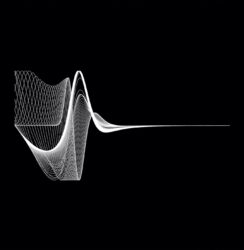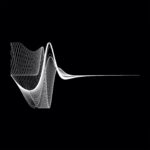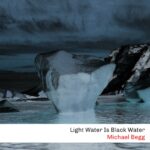VALERY VERMEULEN – MIKROMEDAS AdS/CFT 001
If I thought about how approaching a black hole might sound, I imagined that either the sound slowly would grow louder and louder until my head imploded from the overall pressure. Or: that the sound would slowly recede because it was absorbed by the enormous gravity, so it would end in total silence. Before my head exploded. I’m afraid this only demonstrates that I really have no clue regarding this dark matter.
Because Mikromedas AdS/CFT 001 sounds quite different from what I imagined.
(Dr.) Valery Vermeulen produced these sounds “using data streams generated by various simulation models of astrophysical black holes and observational data of regions in space with extreme gravitational fields.”
The data used include “gravitational wave data, data generated by black branes (i.e. higher dimensional generalizations of black holes), neutron star data, data from white dwarfs and trajectory data of elementary particles near black holes.”
This doesn’t necessarily mean that I know what I’m talking about now: these are complex matters. But I trust that Vermeulen knows what he’s talking about because he’s not only a Belgian musician but also a researcher at the Department of Mathematics – Computer Science at the University of Antwerp. Combining these pieces of knowledge led him to design and program innovative data sonification systems and techniques.
For Mikromedas, he collaborated with academic partners such as the Department of Physics and Astronomy of Alabama, the Institute for Theoretical Physics, and the Centre for Mathematical Plasma Astrophysics of KU Leuven, etc. etc.
It’s important to know that this album Mikromedas AdS/CFT 001 is only one specific section of the Mikromedas project. The AdS/CFT performance series started in 2019 and studies “black hole astrophysics and regions with extreme gravitational fields”.
Apart from this, the OGLE2005BLG390Lb performance series (started in 2014) thematically describes the “possible voyage from earth to the exoplanet OGLE2005BLG390Lb situated near the center of our Milky Way, Sagittarius A*.”
So: we’re talking serious researched material here. But apart from all the background theories involved the sonic result is important. And that part is also very adventurous: it is an engaging and surprising, ever-changing sonic experience you can best submit to. Even though I have no clue about the exact relation between the sounds and the underlying data, and in no way I can comprehend the complexities involved when observing black holes.
Sit back, fasten your seat belts, and, like Buzz Lightyear said: “To infinity, and beyond!”
note: this is the preview trailer. The full album will be available on December 3, 2021.
MICHAEL BEGG – LIGHT WATER IS BLACK WATER 
When talking about data-driven composition, the work of Michael Begg cannot remain unmentioned. The data for his Witness series previously involved the movement of satellites, the weather, or air inequality – and resulted in engaging music, also performed live with the Black Glass Ensemble.
Light Water Is Black Water is the result of a commission from the Ocean Arctic Partnership, “established to bring creatives and marine climate scientists together to increase public engagement with marine data science.”
All of this music “is the product of the data. The melodic lines, the harmonic content, the timbre, amplitude, and mode arise from daily average data points for ice concentration and thickness, air temperature, pressure, precipitation, and evaporation.”
To Michael Begg’s greatest surprise, the data “did not speak of wild fluctuations and atonal ruptures to harmony or structure. The data spoke only of these fractional changes, a degree here, a metre there, that brings our survival into question.”
This can be heard also in the resulting music, which “articulate a richly textured and complex balancing act.”
As difficult as it may be to comprehend the complex algorithms behind the process, data-driven compositions help us to connect with the environment around us, even if that may be in a subconscious way.
Whether the data come from black holes, from the movements of stars, or from the natural environmental processes of our earth: even if you can’t comprehend it, you’ll simply feel its importance.
The download of this album includes a 13-page booklet with commentary from the artists and scientists involved, as well as some more background information on the project.





